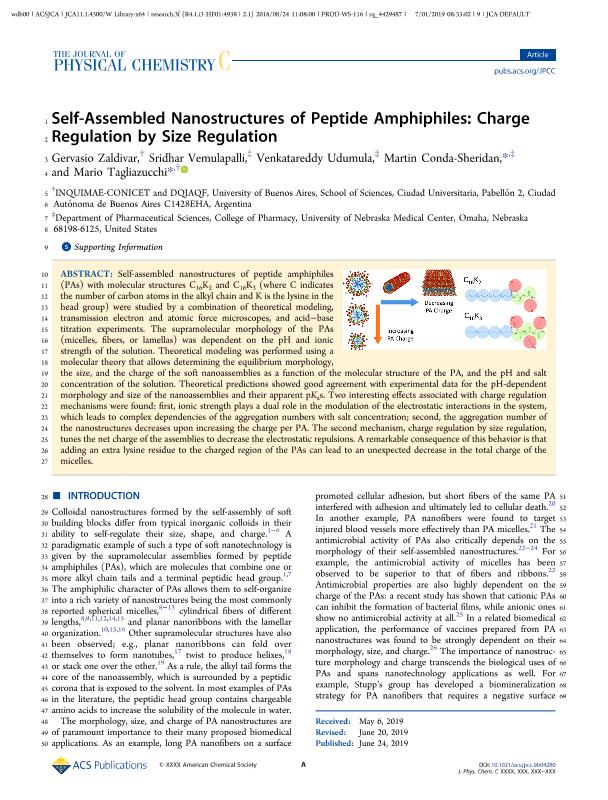Artículo
Self-Assembled Nanostructures of Peptide Amphiphiles: Charge Regulation by Size Regulation
Zaldivar, Gervasio ; Vemulapalli, Sridhar; Udumula, Venkatareddy; Conda Sheridan, Martin; Tagliazucchi, Mario Eugenio
; Vemulapalli, Sridhar; Udumula, Venkatareddy; Conda Sheridan, Martin; Tagliazucchi, Mario Eugenio
 ; Vemulapalli, Sridhar; Udumula, Venkatareddy; Conda Sheridan, Martin; Tagliazucchi, Mario Eugenio
; Vemulapalli, Sridhar; Udumula, Venkatareddy; Conda Sheridan, Martin; Tagliazucchi, Mario Eugenio
Fecha de publicación:
06/2019
Editorial:
American Chemical Society
Revista:
Journal of Physical Chemistry C
ISSN:
1932-7447
Idioma:
Inglés
Tipo de recurso:
Artículo publicado
Clasificación temática:
Resumen
Self-assembled nanostructures of peptide amphiphiles (PAs) with molecular structures C16K2 and C16K3 (where C indicates the number of carbon atoms in the alkyl chain and K is the lysine in the head group) were studied by a combination of theoretical modeling, transmission electron and atomic force microscopes, and acid-base titration experiments. The supramolecular morphology of the PAs (micelles, fibers, or lamellas) was dependent on the pH and ionic strength of the solution. Theoretical modeling was performed using a molecular theory that allows determining the equilibrium morphology, the size, and the charge of the soft nanoassemblies as a function of the molecular structure of the PA, and the pH and salt concentration of the solution. Theoretical predictions showed good agreement with experimental data for the pH-dependent morphology and size of the nanoassemblies and their apparent pKa's. Two interesting effects associated with charge regulation mechanisms were found: first, ionic strength plays a dual role in the modulation of the electrostatic interactions in the system, which leads to complex dependencies of the aggregation numbers with salt concentration; second, the aggregation number of the nanostructures decreases upon increasing the charge per PA. The second mechanism, charge regulation by size regulation, tunes the net charge of the assemblies to decrease the electrostatic repulsions. A remarkable consequence of this behavior is that adding an extra lysine residue to the charged region of the PAs can lead to an unexpected decrease in the total charge of the micelles.
Palabras clave:
charge regultation
,
molecular theory
,
micelles
,
fiber
Archivos asociados
Licencia
Identificadores
Colecciones
Articulos(INQUIMAE)
Articulos de INST.D/QUIM FIS D/L MATERIALES MEDIOAMB Y ENERGIA
Articulos de INST.D/QUIM FIS D/L MATERIALES MEDIOAMB Y ENERGIA
Citación
Zaldivar, Gervasio; Vemulapalli, Sridhar; Udumula, Venkatareddy; Conda Sheridan, Martin; Tagliazucchi, Mario Eugenio; Self-Assembled Nanostructures of Peptide Amphiphiles: Charge Regulation by Size Regulation; American Chemical Society; Journal of Physical Chemistry C; 123; 28; 6-2019; 17606-17615
Compartir
Altmétricas



